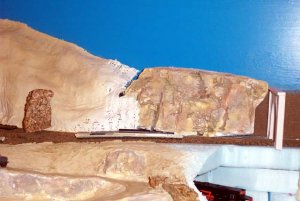I have recently begun making my mountains by wading up newspapers and covering with plaster cloth. I attempted to color the plaster cloth once dry and noticed it didn't quite look right (could still see too many holes from the cloth, etc). I placed a skim coat of Sculptamold over the dryed plaster cloth, and the mountains now look ready to really be colored 
Could anyone recommend a good color wash formula / technique I could use for the base color of my mountains? I have all of the Woodland Scenices colors such as Earth Undercoat, Black, Slate Gray, ad naseum... I am just not sure what a good method of getting a good looking color on the sculptamold would be.
Thanks,
--Rob.
Could anyone recommend a good color wash formula / technique I could use for the base color of my mountains? I have all of the Woodland Scenices colors such as Earth Undercoat, Black, Slate Gray, ad naseum... I am just not sure what a good method of getting a good looking color on the sculptamold would be.
Thanks,
--Rob.


